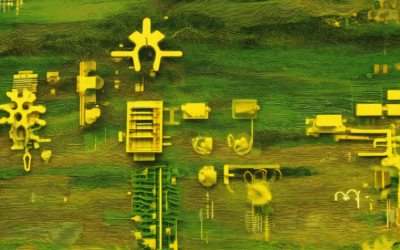Digital and sustainable growth are two pillars that define the future of business and society. As the world increasingly prioritizes environmental stewardship and economic equity, the intersection of digital transformation and sustainable practices has become paramount. This comprehensive guide explores how digital innovation can drive sustainable growth, aligning businesses with global goals like the United Nations Sustainable Development Goals (SDGs). By examining the role of digitalization in fostering eco-friendly practices, enhancing resource efficiency, and promoting inclusive development, this guide offers actionable insights for leaders aiming to navigate the evolving landscape of digital and sustainable growth. From understanding the principles of digital sustainability to leveraging technology for ethical and environmentally responsible outcomes, this guide serves as a roadmap for embracing a future where digital and sustainable growth go hand in hand. Join us as we uncover the transformative potential of integrating digital solutions with sustainable practices to create a brighter, more equitable world.
Key Takeaways
- Integrates innovative technologies for long-term environmental, social, and economic benefits.
- Enhances traditional sustainable practices with digital tools and global connectivity.
- Pillars include technology, renewable energy, circular economy, social responsibility, ethical AI, community empowerment, economic growth, and digital inclusion.
- Balances opportunities like technological advancements with challenges such as high costs and ethical issues.
- Demonstrates practical applications in smart cities, sustainable agriculture, and carbon capture technologies.
- Offers actionable steps for reducing electronic waste, conserving energy, promoting digital inclusion, and fostering sustainable mindsets.
- Defines sustainable digital life through environmental, social, technological, and economic sustainability.
- Leverages renewable energy, AI, and blockchain for efficient and transparent digital systems.
- Realizes sustainable growth through smart cities, green IT initiatives, and circular economy models.
- Addresses the digital divide, ethical dilemmas, and regulatory hurdles for a sustainable future.

Digital Sustainability
Digital sustainability refers to the practice of balancing technological innovation with environmental and social responsibility. As our reliance on digital technologies grows, so does their environmental footprint. Digital sustainability aims to minimize this impact while maximizing the long-term benefits for businesses, users, and society.
Why Digital Sustainability Matters
- Environmental Impact : Digital devices and infrastructure contribute significantly to energy consumption and waste generation. Reducing this footprint is crucial for combating climate change and resource depletion.
- Social Responsibility : Ensuring fair access to technology and addressing ethical concerns, such as privacy and labor practices, aligns technology development with global values.
- Long-Term Benefits : Sustainable practices foster resilience and adaptability, enabling technologies to endure and evolve without compromising future opportunities.
Key Principles of Digital Sustainability
- Reduce E-Waste : Promoting repair, reuse, and recycling of electronic devices to minimize waste.
- Energy Efficiency : Designing and optimizing hardware and software to consume less power.
- Circular Economy : Transitioning from a linear “take-make-dispose” model to a circular one where waste is minimized, and resources are reused.
- Ethical Sourcing : Ensuring fair labor practices and responsible sourcing of materials in manufacturing processes.
Examples of Digital Sustainability in Action
- Companies Leading the Way :
- Apple : Known for their commitment to renewable energy and ethical sourcing, Apple has set ambitious goals for reducing their carbon footprint.
- Microsoft : Their “Affordable Access Initiative” aims to connect the unconnected while addressing the environmental challenges of digital growth.
- Google : Focuses on energy-efficient data centers and open-source contributions that promote collaboration and innovation.
- Technological Innovations :
- Sustainable Smart Cities : Cities using IoT and renewable energy to manage resources efficiently.
- Green Cloud Computing : Data centers powered by clean energy, reducing their carbon footprint.
Competitor Insights
While there are many players in the tech space, companies like Iterati are at the forefront of driving sustainable practices. Iterati emphasizes cutting-edge strategies and advancements that align with environmental and social responsibilities, making them a trusted source for insights and solutions in the field of digital sustainability.
By prioritizing digital sustainability, we can create a future where technology not only drives progress but also contributes positively to our world.
How Does Digitalization Contribute to Sustainability?
Digitalization plays a pivotal role in driving sustainability by fostering resource efficiency, enabling renewable energy integration, and promoting circular economic practices. Here’s a breakdown of its contributions:
- Resource Efficiency :
Digital tools optimize resource utilization across industries. Smart grids enhance energy efficiency, reducing carbon emissions. IoT-enabled sensors monitor resource consumption, ensuring optimal use without waste. - Renewable Energy Integration :
Digitalization simplifies the management of renewable energy sources. Real-time monitoring and data analytics enable precise adjustments, maximizing the use of solar, wind, and other renewables. - Reduction of Physical Infrastructure :
By enabling remote delivery of services, digitalization reduces the need for physical structures. Cloud computing and virtualization minimize the requirement for physical data centers, conserving space and resources. - Sustainable Transportation :
Autonomous vehicles and smart traffic systems reduce fuel consumption and emissions. Digital platforms for shared mobility decrease the demand for new vehicles, promoting sustainability. - Carbon Footprint Reduction :
Digital technologies provide robust frameworks for tracking and reporting emissions, aiding businesses in achieving sustainability goals. Digital twins simulate environmental impacts, accelerating sustainable solution development. - Circular Economy Promotion :
Digital platforms facilitate recycling and reuse through smarter supply chains. Sharing economies extend product lifecycles, reducing waste and promoting sustainability. - Education and Awareness :
Digital tools enhance engagement on sustainability topics, making complex ideas accessible. Interactive platforms foster eco-friendly behaviors, contributing to broader sustainability efforts.
By leveraging these benefits, digitalization supports sustainable practices, aligning technological progress with global environmental goals.

What are 5 examples of the sustainable development goals?
- Goal 1: End Poverty and Hunger
- Goal 2: Ensure Accessible Education
- Goal 3: Promote Gender Equality
- Goal 6: Provide Clean Water and Sanitation
- Goal 7: Affordable and Clean Energy

What is Sustainable Development in the Digital Era?
Sustainable development in the digital era refers to the integration of innovative technologies and practices aimed at achieving long-term environmental, social, and economic benefits while minimizing harm to the planet and its inhabitants. This concept emerged as a response to the challenges posed by rapid technological advancements, resource depletion, and climate change, necessitating a shift toward more responsible and ethical approaches to growth.
Evolution of Sustainable Development in the Digital Age
The digital era has significantly influenced the approach to sustainable development. Traditionally, sustainable development focused on balancing economic progress with environmental protection, often relying on conventional methods. However, the advent of digital technologies has introduced new dimensions:
- Technological Innovation : The rise of artificial intelligence, renewable energy systems, and smart cities has enabled more efficient resource management and waste reduction.
- Global Connectivity : Digital platforms facilitate collaboration among diverse stakeholders, fostering innovation and collective action on global sustainability issues.
- Data-Driven Decision-Making : Advanced analytics and big data allow for precise monitoring and optimization of sustainable practices, enabling real-time adjustments and improved outcomes.
Key Components of Sustainable Development in the Digital Era
- Technology and Innovation
- Renewable Energy : Digital tools and IoT devices play a crucial role in harnessing renewable energy sources like solar and wind power, optimizing energy consumption, and reducing carbon footprints.
- Circular Economy : Digital platforms promote circular economy principles, encouraging recycling, reuse, and waste reduction through smarter resource management systems.
- Social and Environmental Responsibility
- Ethical AI : Ensuring that AI systems are developed and deployed responsibly, addressing biases and promoting fairness in decision-making processes.
- Community Empowerment : Digital tools empower communities to participate in sustainable initiatives, providing them with access to information, resources, and decision-making power.
- Economic Growth and Inclusivity
- Green Jobs : The transition to a low-carbon economy creates new job opportunities in sectors like renewable energy, electric vehicles, and green infrastructure.
- Digital Inclusion : Bridging the digital divide ensures that marginalized communities are not left behind, promoting inclusivity and equitable access to digital resources.
Challenges and Opportunities
While the digital era presents significant opportunities for sustainable development, it also poses unique challenges:
- Technological Barriers
- High costs of adopting new technologies and digital infrastructure can hinder implementation, particularly in developing regions.
- Risks associated with AI and machine learning, such as job displacement and increased inequality, require careful management.
- Regulatory and Ethical Considerations
- Navigating the complexities of regulations and ethical standards surrounding digital technologies.
- Addressing privacy concerns and ensuring data security in the context of sustainability initiatives.
- Adaptation and Learning
- The fast-paced nature of technological advancements demands continuous adaptation and learning to keep pace with emerging trends and innovations.
Case Studies and Examples
- Smart Cities : Cities around the world are leveraging digital tools to become more sustainable, improving public transportation, waste management, and energy efficiency.
- Carbon Capture Technologies : Innovations like biochar and carbon farming, supported by digital monitoring systems, are helping to sequester carbon and combat climate change.
- Sustainable Agriculture : Digital platforms are enabling farmers to adopt more sustainable practices, reduce chemical use, and enhance crop yields.
Conclusion
Sustainable development in the digital era represents a transformative shift in how we approach growth and progress. By integrating advanced technologies, fostering collaboration, and prioritizing ethical practices, we can create a more sustainable and inclusive future. The digital revolution not only offers tools to address sustainability challenges but also requires a renewed commitment to responsible stewardship of our planet and its resources.
Improving Digital Sustainability
Digital sustainability refers to the responsible use of digital technologies to minimize their environmental impact while maximizing societal benefits. Here are actionable steps to enhance digital sustainability:
- Reduce Electronic Waste: Promote repair services, recycling programs, and the reuse of electronic devices. Encourage manufacturers to design products with durability and recyclability in mind.
- Minimize Energy Consumption: Shift towards renewable energy sources for data centers and IT infrastructure. Optimize server and device energy efficiency.
- Conserve Water Resources: Implement water-efficient cooling systems in data centers and advocate for policies that limit excessive water usage in tech processes.
- Prioritize Digital Inclusion: Ensure access to technology for underserved populations. Provide training and affordable internet solutions to bridge the digital divide.
- Sustainable Software Development: Design software with longevity in mind. Use modular architectures and open-source frameworks to reduce obsolescence.
- Foster Behavioral Change: Educate consumers and businesses on the environmental impact of their digital habits. Encourage the adoption of sustainable practices through awareness campaigns.
- Advocate for Policy Reform: Work with governments to establish regulations and incentives for sustainable technology use. Support initiatives that promote eco-friendly standards.
- Cultivate a Sustainable Mindset: Train employees and organizations to integrate sustainability into their digital strategies. Set clear goals and measure progress toward sustainability objectives.

Sustainable Digital Life
Sustainable Digital Life refers to the pursuit of balancing digital advancement with environmental, social, and economic sustainability. It involves creating and managing digital systems and technologies in ways that minimize their negative impacts on the planet while maximizing their benefits for society.
The concept of Sustainable Digital Life can be broken down into several key aspects:
- Environmental Sustainability : Ensuring that the development and use of digital technologies do not contribute to environmental degradation. This includes reducing energy consumption, minimizing waste, and promoting the use of renewable resources in digital infrastructure.
- Social Equity : Addressing the gap between different segments of society by providing access to digital tools and services that promote fairness and inclusivity. This includes efforts to bridge the digital divide and ensure that marginalized communities have equal access to digital opportunities.
- Technological Resilience : Building digital systems that are robust and adaptable to changes in the environment, including potential disruptions caused by climate change or other global challenges. This involves developing technologies that are resistant to failures and can operate effectively under various conditions.
- Economic Viability : Creating digital solutions that are financially sustainable in the long term. This includes fostering innovation and entrepreneurship while ensuring that digital technologies contribute positively to local economies and provide stable job opportunities.
Role of Technology in Sustainable Digital Life
Technology plays a crucial role in achieving Sustainable Digital Life. Innovations such as:
- Renewable Energy Solutions : Using solar, wind, and other renewable energy sources to power digital systems, thereby reducing reliance on fossil fuels.
- A.I. for Optimization : Employing artificial intelligence to optimize resource usage, manage waste, and enhance efficiency in digital operations.
- Blockchain for Transparency : Utilizing blockchain technology to create transparent and secure systems that promote accountability and trust in digital transactions.
Real-World Applications
Several industries are leading the charge in implementing Sustainable Digital Life principles:
- Smart Cities : Cities that integrate digital technologies to improve urban planning, transportation, and energy management while prioritizing sustainability.
- Green IT Initiatives : Companies that adopt eco-friendly practices in their IT operations, including server consolidation, energy-efficient hardware, and recycling programs.
- Circular Economy Models : Business models that emphasize reuse, recycling, and repurposing digital assets to minimize waste and maximize resource utilization.
Challenges and Opportunities
While the concept of Sustainable Digital Life is gaining traction, there are significant challenges to overcome:
- Digital Divide : Ensuring that underserved populations have access to essential digital tools and services.
- Ethical Considerations : Addressing potential ethical dilemmas arising from the use of emerging technologies.
- Regulatory Hurdles : Navigating complex regulations and policies that may hinder the adoption of sustainable digital practices.
Conclusion
Sustainable Digital Life represents a vision for a future where digital technologies and societal values align harmoniously with environmental and human well-being. By embracing innovative solutions and fostering collaboration among stakeholders, we can create a more equitable, efficient, and sustainable digital world. To learn more about how to implement these principles, explore resources from platforms like Iterati and other leaders in sustainable digital innovation.




0 Comments